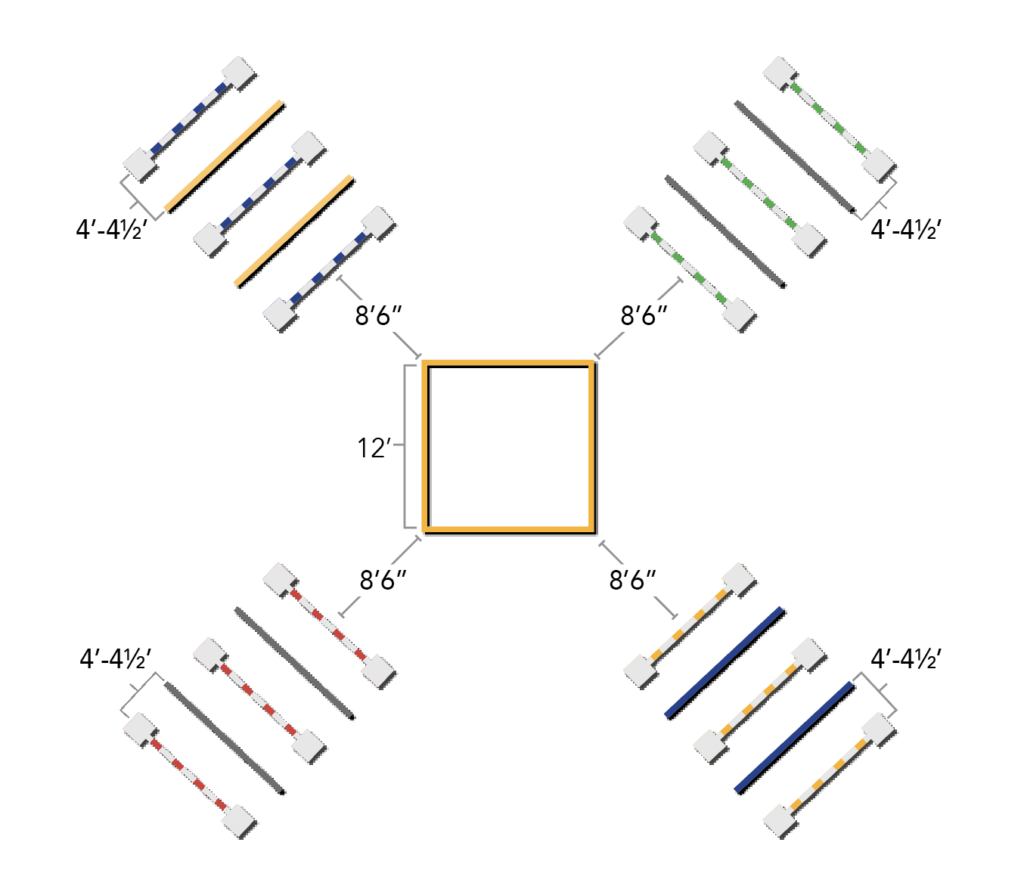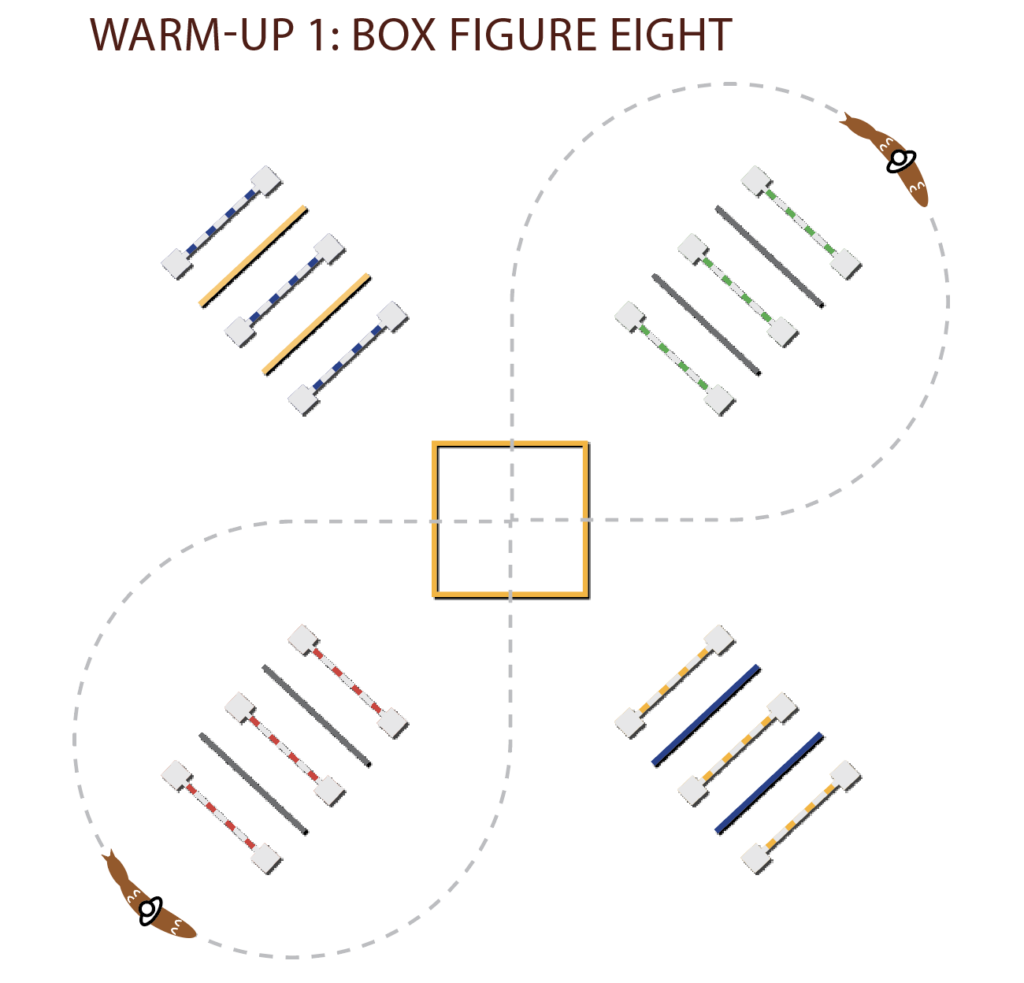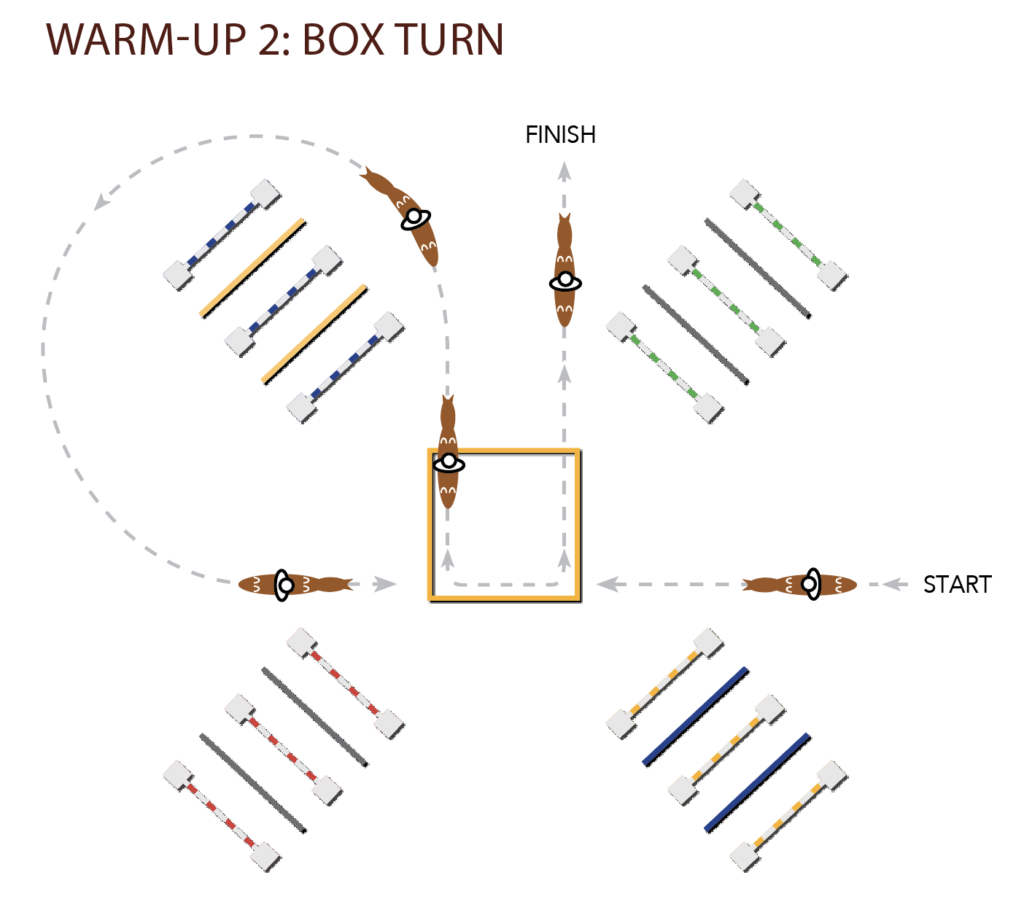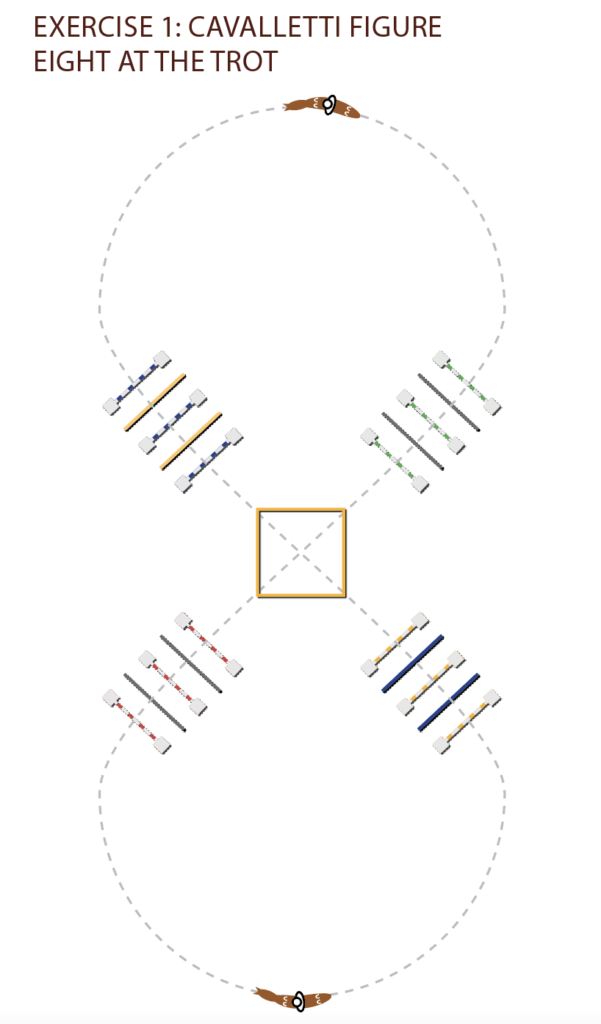Looking for a simple way to spice up your schooling at home? Try cavalletti work. Regardless of your discipline or level, riding over and between poles can improve:
- your horse’s strength, balance, rhythm, tempo and connection
- your accuracy on circles, turns and straightaways
- simple changes
- transitions and more.
In this article, I’ll share several exercises that will work toward all of these goals. Be sure you understand each entire “course” or pattern before you start. Once you’ve gotten the hang of them, focus on your position as you practice the exercises. Go through a mental checklist over and over: How is my position and alignment, where are my elbows, spine, seat bones, legs, weight?
Don’t worry if your horse makes mistakes. Just stop, take a deep breath and calmly repeat the exercise until he figures it out. When he does, give him a walk break and plenty of pats and praise.

© Sandra Oliynyk
Exercise Setup
For these exercises, you’ll need 24 solid, heavyweight poles (at least four of which are 12 feet long—the rest can be anywhere between 8 and 12 feet). More advanced riders will also need 12 pairs of solid, unbreakable risers that can lift poles approximately 8 inches off the ground.
Build a square box in the middle of your arena out of the four 12-foot poles. Perpendicular to each of the box’s corners, build a set of cavalletti out of five parallel poles. Place the poles that are closest to the corners of the box about 8½ feet from it. Space the cavalletti between 4 and 4½ feet apart. The purpose of these exercises is to encourage your horse to compress and lift his stride, not to lengthen it, so try to make the distances at or slightly shorter than his natural stride length. If you’re riding with a group of horses with different stride lengths, making the distance just over 4 feet should suit them all fairly comfortably.
Don’t have enough poles to build this entire setup? You can still perform modified versions of most of these exercises with just the box and one or two sets of cavalletti.

Warm-up 1: Box Figure Eight
Do your regular warm-up at all three gaits, then proceed to a figure eight over the box. Starting on a straight line, approach the center of one side of the box in either rising or sitting trot. Trot over that pole, straight through the middle of the box, and then out over the center of the opposite pole. Focus on maintaining his straightness and a steady tempo.
After you exit the box, loop to the right or left around one set of cavalletti and head straight back through the centers of the remaining two sides of the box. Then loop in the other direction around a set of cavalletti and trot through the center of the box again. Repeat this figure eight two or three times.
As you go over the poles, if your horse hits one, try to identify whether it’s with a front hoof or a hind hoof. If the former, make more half-halts in the approach to the box. This will help to shift his balance onto his haunches, so he can lift his front feet higher. If the latter, you may need to add slightly more leg aid to engage his hind legs. As the exercise progresses, he should start to pick his feet up higher. If he doesn’t, check with a trainer because some horses don’t figure this out or aren’t careful enough and continue to hit poles.
Horses sometimes miscalculate their timing, get too close to a pole and hit it. If your horse does this, continue on as if nothing happened. Most horses will learn to adjust with practice.

Warm-up 2: Box Turn
Next, trot straight toward one of the poles of the box, this time slightly off-center on the side opposite to the direction you’re traveling. (So, for example, if you’re tracking right, aim for the section left of the center of the pole.) After you trot over the pole, make a smooth, 90-degree turn inside the box, as if you were riding through a corner in a dressage ring. Then continue trotting straight out over the pole perpendicular to the one you went over to enter the box. Straighten your horse and turn in the opposite direction (in this case, left).
Loop around a set of cavalletti and approach the box just as you did before, this time aiming to enter over the other side of the pole’s center (in this example, the right side) and preparing to ride a 90-degree turn inside the box (in this example, turning left). After you exit the box, continue straight, then turn in the opposite direction.
How deeply you ride into each corner depends on your level. If your and/or your horse are less experienced, make these turns fairly shallow. If you’re more advanced, challenge yourself by going deeper—but never so deep that you disrupt your horse’s balance or tempo.
Troubleshooting: If your horse rushes and/or overshoots the turn and steps out of the box, don’t make a big deal out of it. Just circle around in the same direction and approach the box again. This time, make more half-halts, asking him to wait and compress his stride before you enter the box. Then ride the turn in a shoulder-fore, using your inside leg to create more bend through the middle of his body. Use your outside aids to create a “wall” controlling the shape of the turn: Drop your weight down into your outside seat bone, step down through your outside leg, and drop your outside elbow down, gently hugging your side. Half-halt with your outside rein as frequently as necessary around the turn, trying to make every stride the same.

Exercise 1: Cavalletti Figure Eight at the Trot
Now you’re ready to tackle the cavalletti. Whatever your level, start with all of the poles on the ground. Trot straight down one diagonal through the center of the first set of cavalletti. Continue trotting directly over the point of the box corner, then diagonally across the box, out over the opposite point, and straight through the next set of cavalletti.

After the second set of cavalletti, turn left or right and loop around to the other diagonal. Ride straight through in the same fashion, then turn in the opposite direction you did after the first diagonal (turn left if you turned right earlier), creating a figure eight. Throughout the exercise, focus on straightness and keeping the tempo and length of stride consistent.
As you go over the poles, stretch up tall, square and straight in your upper body and, with steady, quiet hands, keep your horse’s body straight between your legs, seat and elbows. Whenever you can, soften your reins to allow your horse to look down at the poles and figure out what he needs to do. Eventually, the goal is for him to relax and stretch over his topline and swing his back freely.
Throughout the first diagonal, ask yourself, “How is he negotiating the poles? Does it feel like he needs a bit more tempo—or less? Is he drifting right or left?” Make whatever adjustments are necessary before the next diagonal—adding more leg or half-halts or “closing the door” as you did in the box-turn warm-up.
Troubleshooting: If your horse runs through the first diagonal too quickly, trips, breaks into the canter or jumps a pole, make as many transitions to walk or halt on the turn as needed to get his attention. Prepare to walk or halt inside the box as you ride down the next diagonal. Then take a breath to the next set of cavalletti. As you repeat the figure eight, just think of walking in the box, but continue in the trot. Sometimes this is all it takes to reset the tempo.
Initially, you might need to half-halt with every stride, in rhythm with his steps as he goes over the cavalletti. Think “balance and wait, soften, balance and wait, soften.” As your horse relaxes, you’ll be able to half-halt less frequently. Using the shoulder-fore throughout the exercise may help as well. Another way to settle a quick horse is to ride a diagonal in a different direction. Sometimes such a small change can make all the difference you need.
Eventually, you’ll get to the point where your horse waits long enough for you to put your leg on to ask for more power. That’s your goal: being able to request more push from behind, which will create more lift over the poles and eventually more lift in your horse’s normal gaits.
Advanced version: After riding through the figure eight two or three times, raise the 12 alternating cavalletti onto their risers. Then repeat the exercise. Be prepared. Some horses don’t notice the change in height and trip as a result. After that’s happened, they pick their feet up higher. As you ride over the raised poles, visualize a passage: with more lift off the ground, not longer steps.
Exercise 2: Spiral In and Out Between Cavalletti
This exercise will help you stay honest in the shape and size of your circles. Start by trotting a large circle around the entire setup. Then spiral slightly in to ride a circle between the two outermost poles of each set of cavalletti. This is an approximately 20-meter circle. Continue bending your horse around your inside leg throughout the circle, even as you trot between the poles. (There is enough space for you to bend there, rather than straightening.) Then gradually spiral in again, making a circle through the next pairs of poles.
Continue until you reach the smallest circle on which your horse can still maintain his balance, tempo and gait quality. (The smallest circle you can make in this exercise is 6 meters just around the center box. But I recommend that only if you are practicing the 8-meter volte.) At this point, you’ll need to keep turning with every single step. Stay tall and square in your upper body. Focus on keeping your position level and even on both sides of your body. Drop your weight evenly down both legs and lower both elbows toward your seat bones. Use your outside aids to control the outside of the circle, just as you did in the warm-up corners—but soften the outside rein when necessary to allow the bend.
Gradually spiral back out to the 20-meter circle. Then make a half-halt to prepare for a canter transition. Take a moment to check your connection—you want to feel like the bit connects through the reins to your elbows and armpits, which connect down your back to your seat bones. The good bend and rhythm produced in the spiral usually sets horses up for a nice, smooth transition. Continue cantering a full 20-meter circle, then take a walk break before repeating the exercise in the other direction.

Exercise 3: Canter Bounce and Simple Change
This exercise is an excellent test of your accuracy and your connection to your horse through your outside aids. It also makes horses think about where their feet are.
Begin at the canter on a small circle hugging the outside of one set of trot cavalletti. As you circle around toward the box, cut across the corner of it, so that your horse steps over one pole, lands inside the box, then steps out over the adjacent pole—like a bounce in jumping. Then circle around the same trot cavalletti again.
As you turn toward the box the second time, straighten your horse and aim for the center of the pole. Several strides before you get to it, make a transition to trot or walk. Ride straight over the pole, across the middle of the box and out over the opposite pole. Then change the bend and pick up the canter in the opposite lead to the one you started on. (So, for example, if you started on your right lead, pick up your left lead here.) Repeat the exercise in this direction: circling around the closest set of trot cavalletti, bouncing through the corner of the box, circling again, then straightening and making a walk or trot transition before riding through the box, then picking up the other lead upon exiting.
Repeat the entire exercise twice, so your horse gets a chance to figure it out in both directions.

Troubleshooting: The most critical moments in this exercise are the approaches to the box and the bounce into and out of the box. If your horse drifts wide on the turn across the box corner, the distance will change, potentially creating an awkward step. To prevent him from drifting wide the next time, “close the door” with your outside aids and check that you’re not leaning in.
If he breaks to trot midway across the box corner, he might not be seeing his stride. The next time through, support him with more leg.
You’ll be amazed at how quickly your horse picks up this complicated exercise. It is another strength-building test that challenges him to bend the joints more in his hind legs and carry himself better. If he starts to make mistakes, like picking up the wrong lead or swapping leads, that may indicate that he and/or you are growing fatigued. Try to do one more good repetition, then call it a day.

© Sandra Oliynyk
About Michele Wellman
Michele Wellman began her riding career as an eventer, competing through the Preliminary level. She eventually transitioned to dressage and is now a U.S. Dressage Federation bronze and silver medalist, working her way up to Grand Prix. Also a U.S. Eventing Association Level 3 Certified Eventing Coach, Wellman was a mechanical engineer for 16 years before she became a full-time trainer. Combining a love for “thinking about how things work,” with her background in jumping and dressage has led to popular cavalletti clinics, which she hosts monthly for riders of all disciplines at By Chance Farm, in Frederick County, Maryland.
This article originally appeared in the Winter 2022 issue of Practical Horseman.











